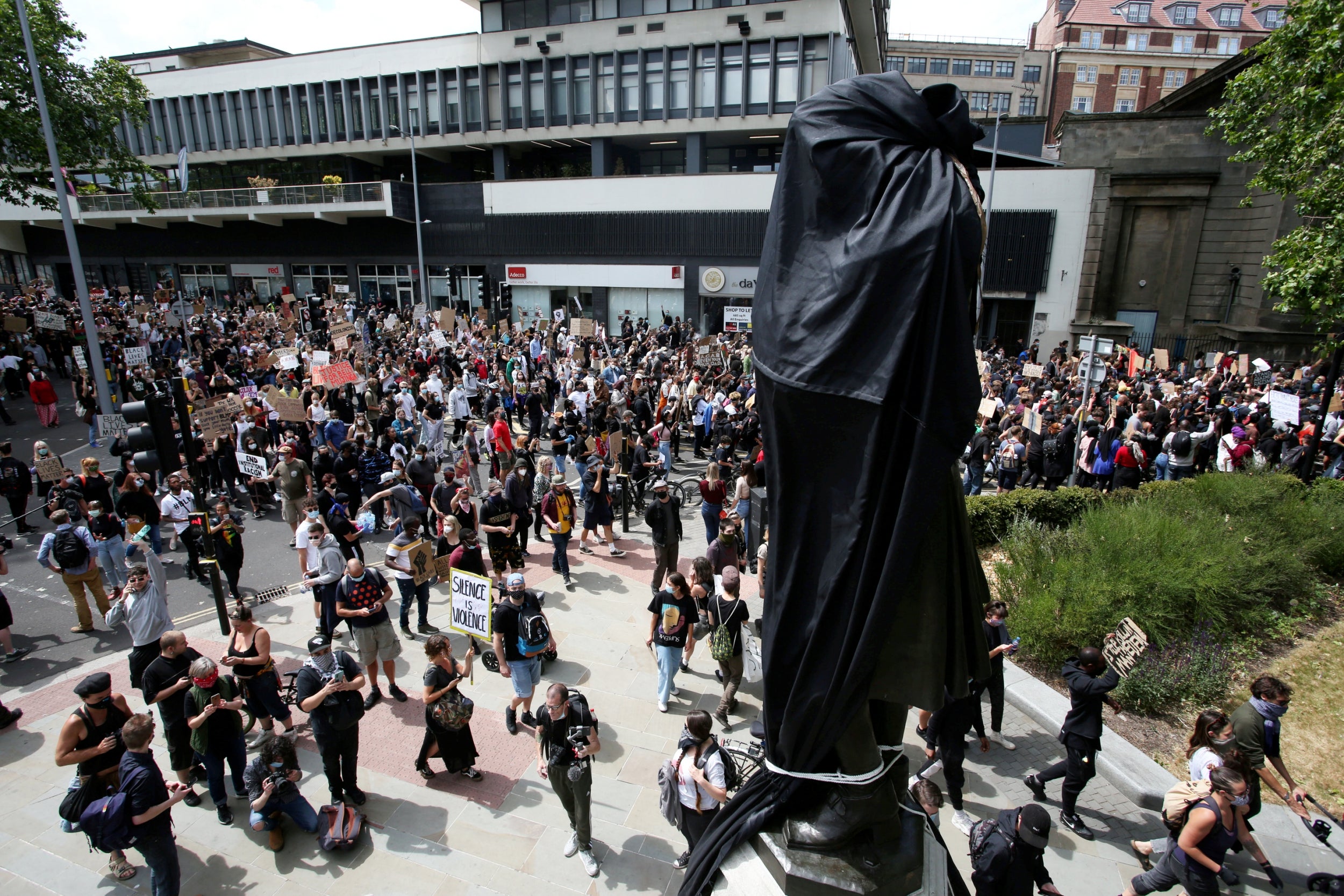Your support helps us to tell the story
From reproductive rights to climate change to Big Tech, The Independent is on the ground when the story is developing. Whether it's investigating the financials of Elon Musk's pro-Trump PAC or producing our latest documentary, 'The A Word', which shines a light on the American women fighting for reproductive rights, we know how important it is to parse out the facts from the messaging.
At such a critical moment in US history, we need reporters on the ground. Your donation allows us to keep sending journalists to speak to both sides of the story.
The Independent is trusted by Americans across the entire political spectrum. And unlike many other quality news outlets, we choose not to lock Americans out of our reporting and analysis with paywalls. We believe quality journalism should be available to everyone, paid for by those who can afford it.
Your support makes all the difference.Historic scenes were witness in Bristol over the weekend as Black Lives Matter protesters pulled down a controversial statue of 17th-century slave trader Edward Colston and rolled the memorial into the Bristol Harbour.
The divisive memorial was erected in 1895, with a plaque that read: “Erected by citizens of Bristol as a memorial of one of the most virtuous and wise sons of their city.”
Colston’s legacy and memory has been honoured in Bristol for centuries, and his name is seen on streets and buildings throughout the city. His statue stood on Colston Avenue, as does Colston Tower; Colston Hall is located on Colston Street; Colston’s Day is celebrated on 14 November, when Colston buns are eaten. A number of schools also bear his name.
Background
Born on 2 November in 1636, Colston grew up in Bristol but moved to London during the English Civil War and never lived in Bristol as an adult.
He became a member of the Royal African Company (RAC) in 1680 and eventually rose to its most senior executive position, Deputy Governor, from 1689 to 1690. The RAC held the monopoly in England on trading on the west coast of Africa in gold, silver, ivory and slaves from 1662.
Slave trading with the Royal African Company
It is estimated that during Colston’s involvement with the RAC, it transported around 84,000 African men, women and children, who were branded with the company’s initials on their chest.
Around 19,300 of them died on their journey to the Caribbean and the rest of the Americas due to unhygienic conditions on the ships. Designed to maximise profit and hold as many enslaved people as possible, the boats were hotbeds for dysentery, dehydration and scurvy.
Those who survived the treacherous journey were sold to planters for cheap labour on tobacco and sugar plantations.
Colston donated much of the wealth he made off human suffering to charities in Bristol and across the country, bequeathing around £71,000 to charity at his death. He also gave extensively to Bristol churches, donated to Queen Elizabeth’s Hospital School and founded a religious school for 100 boys.
Controversial commemoration
Colston’s activities as a major slave trader emerged in a biography of his life and work written by HJ Wilkins in 1920. Numerous calls have been made throughout the years for the statue to be taken down.
In 2018, Bristol City Council added a second plaque to the statue to recognise and acknowledge the people Colston enslaved.

Why was the statue not removed before now?
The action taken by protesters to pull down the statue of Colston on Sunday has been both defended and condemned.
Mark Weston, councillor for Henbury and Brentry who has defended keeping Colston’s name on buildings in the city, said on Facebook: “Destroying parts of our history that you don’t agree with isn’t protest – it’s criminal damage!
“I believe that the perpetrators should be prosecuted for what is a wanton act of criminal damage… Colston, and his slave-trading contemporaries, are a shameful part of our history but we don’t change anything by seeking to remove it. Sanitising the past in this way will achieve nothing.”
Historian David Olusoga, whose BBC2 programme A House Through Time highlighted the city’s past links to slavery, said: “I’m afraid today should never have happened because this statue should have been taken down and it should have been a great collective day for Britain and Bristol when the statue was peacefully taken down and put in a museum which is where, after all, we remember history properly.
“Statues are about adoration. They’re about saying ‘this man was a great man who did great things’. That’s not true. He was a slave trader and a murderer.”
Bristol mayor, Marvin Rees, who is of Jamaican heritage, said he could not “pretend” to have any “real sense of loss for the statue” and said the memorial was a “personal affront” to him.
When asked on BBC’s Today programme why the statue had not been removed since he became mayor in 2016, he said it was something he would have liked to have seen, but was not a priority as austerity, the housing crisis, and soaring child hunger needed to be addressed.
“Secondly, I’m the first directly elected mayor of African heritage in Europe. If I just pitch up and start tearing down all memorials to slavery there would be another debate and I would be on the receiving end,” he added.
Join our commenting forum
Join thought-provoking conversations, follow other Independent readers and see their replies
0Comments